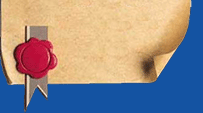|
account
of the rise to the office of mayor of the strange 'legless'
horse is very hard to credit. So here we are left to look
back and wonder, for the history books are somewhat garbled
to say the least and true hard facts are hard to come
by (and even harder to believe when you eventually do
come by them!). In true monarchic tradition, King Erik
was followed by King Erik II, and he by King Erik II,
all the way up until the present day, and our own glorious
Highness, King Erik XV (Footnote #4).
Geography
The
Kingdom of Kerovnia covers an area of one million square
miles (to the inch) and within its boundaries lists an
impressive range of climates and weather zones. Upon its
northern boundaries (with the provinces of Perpetania
and Kerulgia) runs a huge mountain region, split in the
centre by the Obakanga Valley. The two resulting ranges
are the Nattus and the Atina Mountains, to the west and
east of the Obakanga respectively. To the south lies the
thousand square miles of desert, caused by the fact that
Aquitania, Kerovnia's southern neighbour, has all the
water. To the western edge of the realm lies Silenissia,
bordering on the vast reaches of the Dying Forest, which
harbours the last remaining lead mines of the land. Here
also lies The Great Wastelands, their threshold girthed
by fetid swamplands and marshes of a size and depth that
is (for the most part) immeasurable. The eastern edge
of Kerovnia is split by the fiery molten expanse of the
Lava River which issues from the northern Volcano, past
the old emerald mines and Golden Palace, into a steaming
heap within the Aquatica Sea.
With
industries stemming from the enormous tracts of prime
nut yoghurt farming land, the Kingdom of Kerovnia has
much wealth and certainly has need of few imports from
its neighbouring brothers. From chilly Kossa,
|
to
the Mountain City of the north, to the warming fields
of Kerga in the south, life is full of joy and happiness
(Footnote #5). Other industries include emerald and lead
mining, and tourism (especially in the beauty spots of
the snow-capped regions of the north, when paths are not
blocked by boulders (Footnote #6). Tourism in the realm
is monopolised by the Dwarfs, while the Little People
drew the short straw and got the nut yoghurt.
One
problem with the geography of Kerovnia (Footnote #7),
is that it keeps changing; constantly. The explosion of
the Volcano in the reign of King Erik I did catastrophic
damage throughout the Kingdom and left its mark for many
years to come. Things have come and gone, including changes
in land masses (the emergence of the River Nasty that
flows from a suddenly appearing northern sea late in King
Erik XIV's reign), population densities (who knows where
the fabled nomadic Swelks have gone to) and urban settlements
(the famed disappearance of Kozza and appearance of Oftitch
and it's unparalleled County Library (Footnote #8).
Politics
A
sore point in Kerovnia.
Flora
& Fauna
Much
of the flora of this extensive empire is little short
of mundane, yet there are notable exceptions. Take for
example the Swelk nomads, as described in the learned
paper by Dr. Jenks, entitled Methods of Fire-walking.
It reads: "Strange as it may seem, the Swelk nomads,
in the few seconds before their dazzling feats of fire-walking,
apply succulent Gerominitus on soles of their feet. This
not only protects them completely, but also smells of
hot marshmellows when
|
toasted.'
Yet, the subject of fauna is much more diverse:
Ice
Constricting Snake
The only surviving specimen is kept in the Kerovnian Zoological
and Botanical Gardens. Once predominant in the ice regions
of the Kerovnian plateaus, they were all eliminated during
the great thaw except 'Lawrence', who survived by hiding
inside a giant snowman.
Pink
Unicorns
These fabulous creatures are now indigenous to the Northern
Mountains and usually used as sightseeing mounts by the
droves of tourists that visit the region all year round.
These unicorns were introduced by The Little People three
centuries before the reign of King Erik I, when Faldous,
the then King of Aquitania, gave the King of Kerovnia
a red unicorn stallion as a birthday gift.
Kattish
Dorabs
Dorabs are a cross between a rabbit and a dog. They are
prized for their hunting abilities, but also make excellent
pets. They have the body of a spaniel and the soft fur
and droopy ears of a bunny. Loved by royalty, the most
famous of all the world's (ever-increasing) population
is Poops, pet and present on Princess Lacey's sixteenth
birthday.
Currency
The
commonest form of currency is the Ferg. This comes in
varying forms of denominations, the one, two and five
Ferg coins being the most available. There are bank notes
too and these usually depict famous figures in Kerovnia's
history (usually Kings - as in the case of the 5 Ferg
note which is printed with the head of King Randolph Ferg
the Fearless). Due to the vast fluctuations in the Ferg's
value, recent times have made it virtually useless, and
barter throughout history has always been popular.
|


